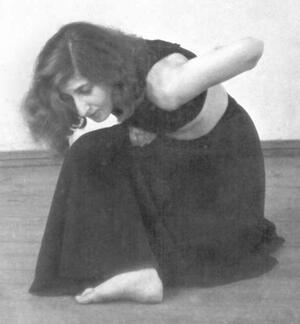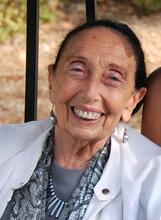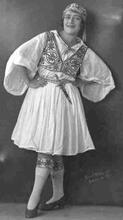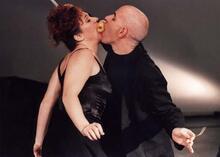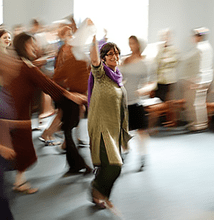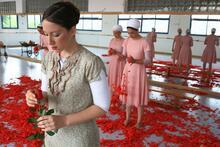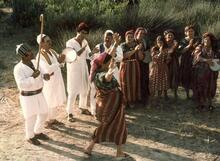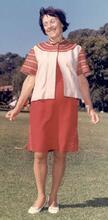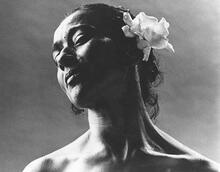Yardena Cohen
Incorporating biblical themes and Sephardic music into her dances, Yardena Cohen helped create a uniquely Israeli artistic culture. Cohen joined the youth group Mahanot ha-Olim and helped found Kibbutz Bet ha-Shittah with them before a fellow kibbutznik, American-born Shemaryah Tzameret, gave her the funds to study dance formally in Vienna in 1930. She returned to Palestine in 1933, opened her own dance studio in Haifa, and taught dance in elementary schools while choreographing performance pieces for herself. Her dances incorporated biblical themes, Middle Eastern costumes, and Sephardic music. In 1937 she won first prize in the National Dance Contest in Tel Aviv. She continued to teach well into her nineties and in 2010 was awarded the Israel Prize for Lifetime Achievement.
Early Life and Family
Yardena Cohen, daughter of Miriam Rafalkes and Pinhas Cohen (1887–1956), was born on July 1, 1910, in Wadi Nisnas (the Arab name of a district near the Haifa port). Yardena was the oldest of three children; the others were musicologist and writer Ruth Keviti Jordan (c. 1921–c. 1997) and Nir. Her father, who was born in Zikhron Ya’akov, graduated first from the Mikveh Israel agricultural school and then from an agricultural college in Berlin. In 1908 he founded the first Hebrew school in Haifa. Her mother, who was born near Vilna c. 1880 and was a descendant of the Vilna Head of the Torah academies of Sura and Pumbedita in 6th to 11th c. Babylonia.Gaon (Elijah ben Solomon Zalman, 1720–1797), studied science with Chaim Weizmann in Geneva, and then joined her parents, who were founders of Rehovot. She died in Haifa c. 1960.
Yardena was immensely energetic as a child and was often seen dancing spontaneously, especially on the beach in Bat Galim, Haifa. She studied in Tel Aviv at the Herzlia Hebrew Gymnasia where she joined a youth group, Mahanot ha-female/sing.; individual(s) who immigrates to Israel, i.e., "makes aliyah."Olim, a section of Ha-No’ar ha-Lomed. Here she met Shemaryah Tzameret, an American idealist who had come on Lit. "ascent." A "calling up" to the Torah during its reading in the synagogue.aliyah. Together with the youth group, they worked in the orchards of Haderah and then helped found A voluntary collective community, mainly agricultural, in which there is no private wealth and which is responsible for all the needs of its members and their families.Kibbutz Bet ha-Shittah, where Yardena was known for her spirited impromptu dancing in the evenings. Shemaryah was so moved that he gave his allowance from America to Yardena in order to encourage her to obtain professional training, using his gift as a stipend to study dance in Europe. His hope that she would return with dance skills was fulfilled.
Early Dance Career
In 1930 Cohen went first to Vienna, where she spent two years studying with Gertrud Bodenwieser at the State Academy of Music and Drama and then for a year to Dresden, to the dance studio of Gret Palucca (1902–1993). In 1933 she returned to Palestine, where she taught dance at elementary schools and created solo works, rejecting the style of her European dance teachers and instead incorporating Biblical themes and local visual elements such as fishnets and the hourglass-shaped darbuka drum. Her accompaniment with kanoon, oud, and flute also became Middle Eastern, because she collaborated with Sephardic instrumentalists Eliahu Yedid Levin, Ovadiah Lit. "Eastern." Jew from Arab or Muslim country.Mizrahi and Haim Hayat, with whom she developed solo programs. This was a challenge since these older musicians had never accompanied a free-spirited, original dancer concerned with creating dance for the new Hebrew culture. For example, she requested that they wear Sephardic robes on stage rather than their usual Western-style business suits.
In 1934 Cohen married Ernst Grenewald (born in Vienna and an engineering graduate of the Haifa Technion). They had two children, Dani (b. 1942) and Irit (b. 1948).
In 1937, Yardena entered the National Dance Contest in Tel Aviv, winning first prize for the most original Hebraic The Land of IsraelErez Israel dance. “Cohen captured the audience … an unknown solo dancer, without a studio to back her up … her charisma as a performer with her four Sephardi musicians … playing live music, transformed the stage into a different world, a mix of biblical and Eastern images” (Spiegel 2000). Almost all the characters in Cohen’s dances have related to women characters in the Bible, such as Lot’s wife, Hannah in Shilo, the Witch of Ein Dor, and Hagar.
Dances for Kibbutzim
In the 1940s Cohen created homespun rituals and dance dramas for A voluntary collective community, mainly agricultural, in which there is no private wealth and which is responsible for all the needs of its members and their families.kibbutzim, incorporating Biblical stories set in the same locale as the new agricultural settlements. In 1944 at Kibbutz Ein ha-Shofet, Yardena recreated the ancient festival of the ripening of the first fruits, Hag ha-Bikkurim, plus a Hag ha-Kerem or vineyard festival. Using themes from biblical stories of the Tribe of Benjamin, Cohen took the kibbutz members outside their buildings into the fields, also incorporating the nearby Arab villagers into the action.
A group from Ein ha-Shofet performed some of the dances from this pageant (to music by composer and kibbutz member Izhar Yaron) at the Daliyyah folk dance festival in 1944 despite Cohen’s protestations that she was not creating folk dances. The festival director, Gurit Kadman, insisted that Yardena’s dances had become a folk phenomenon, especially her dance “Mehol Ovadiah” (an ode to one of Cohen’s musicians). At the festival, Yardena’s dances were taught to many participants and thus spread throughout the country and eventually beyond. She combined children and dancers from many different kibbutzim, releasing doves for peace over the audience, a trademark for large gatherings thereafter.
Yardena’s second pageant took place in 1945 at Kibbutz Sha’ar ha-Amakim’s tenth anniversary. In this she included the biblical figures of Deborah, Barak, Jael and Sisera. A cart filled with musicians headed a parade (music by Uri Givon), while dancers carrying pitchers on their heads danced down from the hillsides.
In 1947 Cohen created a water festival for Kibbutz Ginnigar’s twenty-fifth anniversary. She was inspired by biblical stories incorporating water: water rights arguments between the Philistines and the Jews; Hagar seeking water in the desert; Jacob meeting Rachel at the well.
Dance Studio, Awards, and Legacy
Cohen opened her Haifa dance studio in 1933 and maintained it for some seventy years, stressing creative dance. Since she believes that all children should participate together, her students have included Muslims, Christians, Druse, and Jews. Those who have become professional dancers include Yehudit Arnon, founder of the Kibbutz Dance Company, Roni Segal, Rina Yerushalmi, and Yaron Margolin. Folk dance creators include Shalom Herman and the Druze dancer Nissim Nasar Eldeen with his company from Daliyat al-Karmil.
Cohen received the Worthy Citizen of Haifa award in 1983. On February 1, 1999, the fiftieth anniversary of the Department of Physical Education and Sport, she received the Jubilee Prize for being a founder of Israeli dance; on October 26, 2000, she received the Lifetime Achievement Award from the Ministry of Culture, Science and Sport at the Susanne Dallal Dance Center in Tel Aviv; on January 26, 2003, a sold-out Rappaport Theater honored Cohen under the joint sponsorship of the Dance Library of Israel, the Haifa Municipality and the Ministry of Education, Culture and Sport. The highlights were the premiere of a documentary film about Cohen produced by the Dance Library of Israel and a performance by the Kibbutz Dance Company in her honor. She closed the evening with one of her famous poetic blessings.
Yardena Cohen died on January 23, 2012.
Ashkenazy, Ruth. “Celebrating in the Valley and on the Hilltops: Yardena Cohen and the Creation of
Cultural Patterns in Nature-Connected Festivities in Kibbutzim in the 1940s.” Israel Dance Annual (1985):25–29.
Aldeen, Niseem Nisar. “Ha-Debka ha-Druzit be-Doroteha be-Yisrael” (The History of the Druze Debka in Israel) (Hebrew). Daliyat Al-Karmil: 2001.
Barfman, Ora. “Ha-Kena’anit Bat Galim”(Hebrew). Kol-Bi local newspaper, October 20, 2000.
Blumfield, Wendy. “Dancing with the Waves.” Jerusalem Post, July 13, 2001.
Cohen, Yardena. Ha-Tof ve-ha-Yam (The Drum and the Sea) (Hebrew). Tel Aviv: 1976.
Idem. Be-Tof u-Mahol (With Drum and Dance) (Hebrew). Tel Aviv: 1963; Eshel, Ruth. Lirkod im ha-Halom (Dancing With The Dream: The Development of Artistic Dance in Israel, 1920–1964) (Hebrew). Tel Aviv: 1991.
Hazan, Ruth. “Nishmat ha-Mahol shel Yardena (Hebrew).” Al ha-Mishmar, July 11, 1975.
Ingber, Judith Brin. “The Priestesses.” Dance Chronicle (1995): 445–465.
Ingber, Judith Brin. “Shorashim: The Roots of Israeli Folk Dance.” Dance Perspectives (Autumn 1974): 1–59.
Shanit, Gili. producer. ZED films “Ha-Tof ve-ha-Yam” (Hebrew). Produced by the Dance Library of Israel. Premiered January 26, 2003Rappaport Theater, Haifa.
Spiegel, Nina S. “Cultural Formation in Eretz Israel: The National Dance Competition of 1937.” Jewish Folklore and Ethnology Review, 20/1–2 (2000): 24–39.
Spiegel, Nina. Embodying Hebrew Culture: Aesthetics, Athletics, and Dance in the Jewish Community of Mandate Palestine. Detroit: Wayne State University Press, 2013.

